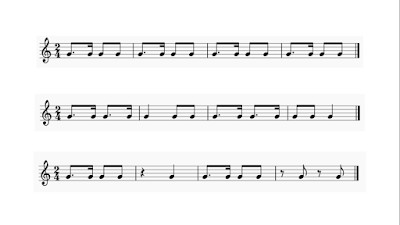Because of the way that Mrs. Hamilton's music classes are set up, I will have the opportunity to teach in each of the four 5th grade classes that she teaches! We will be able to teach the same lesson a few times, exploring with the students. This is wonderful, because we will be able to learn what works for the students and what doesn't.
We have decided to integrate our music teaching with US History, so with some lesson idea help from my mentor, I decided to start with a lesson centered around the song, "Yankee Doodle." Historically, this song provides the opportunity for students to explore the attitudes of the British and Americans in the American Revolution. Musically, I decided that we could also use "Yankee Doodle" to remind the students about the difference between beat and rhythm, learn the dotted eighth note and sixteenth note rhythm, and create a performance of the song by inserting an improvised rhythm section in the middle of the song.
The lesson was split into three parts:
1. Introducing the song, remembering the difference between beat and rhythm, and learning the dotted eighth note and sixteenth note rhythm.
--I clapped the rhythm of the song and students identified the song by its rhythm. We sang the song all together.
--Students sang the song while watching me demonstrate stomping the beat, and then clapping the rhythm. We identified the difference between the two.
--Using notation, students identified quarter notes and eighth notes in "Yankee Doodle" and how many of those notes are within a beat.
--Introduced the dotted eighth note and sixteenth note rhythm in notation. We chanted its rhythm using the words "Yankee Doodle," which is where that rhythm occurs in the song. Also, identified different ways to count a dotted eighth note and sixteenth note followed by two eighth notes (looong-short nor-mal OR 1 a2 + ).
2. Exploring the history of "Yankee Doodle"--how did it come to be and why it is important?
--Invited students to share their ideas with their neighbors and then took some ideas from the class about what they thought "Yankee Doodle" was about. Every time, at least one student already knew that it was originally a song the British sang to make fun of the Americans, but the Americans took it and made it their own. However, we got lots of fun other ideas as well.
--Discussed some of the more unfamiliar terms in the song like "doodle" and "macaroni."
--We sang through the book "Yankee Doodle" by Steven Kellogg, discussing the different scenes we watched the young character move through in the American Revolution.
--Discussed why the Americans took this song and made it their own.
3. Creating a performance of "Yankee Doodle" by singing it as a class with an improvised rhythm section in the middle.
--Split the class into 4 groups. I demonstrated improvising body percussion over 8 beats.
--We practiced each group improvising for 8 beats, each group after the next.
--Put together the song: sang through "Yankee Doodle" once, each group improvised for 8 beats each, then sang "Yankee Doodle" again.
--As time permitted, ran the song again, but each group started their improvised rhythm section with the dotted eighth note, sixteenth note, and 2 eighth notes rhythm.
Reflections
One of the best moments of this lesson occurred right after we put everything together in the third part of the lesson. In the recording (which you can find below), you'll faintly hear one student say, "Let's do it again!" after we finish the song. This was a small comment, but it was highly rewarding! After putting in some really good focus time during the first two portions of the lesson, I was happy that the students were having fun putting everything together.
This first lesson was also a good reminder in how important preparation and classroom management are. One of Mrs. Hamilton's first comments to me after the lesson was something like, "Wow! They respect you. They can tell you're prepared. Classroom management is half of the battle." I was grateful that my lesson was detailed enough that the pacing was fast and helped students stay engaged.
Because Mrs. Hamilton's class is part of a STEAM school, she encouraged me to put my lesson together using Google Slides. This was so effective in my lesson! The students could see exactly what we were doing and I saved lots of time by having all my visual aids in the slides. Mrs. Hamilton considers Google Slides, a microphone, and a seating chart to be three of the most important tools in her classroom. These were all very helpful to me as I taught.
The next week Mrs. Hamilton was going to have a substitute , so we didn't think I would be able to teach. However, after doing this first lesson, Mrs. Hamilton had me come teach the next 5th grade class with the substitute. I'm glad that we're off to a great start!
**********************************************************************************************


